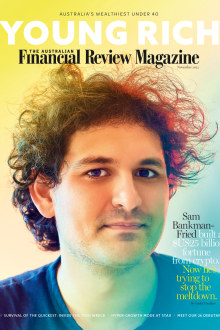Crypto disasters show that even giants can misunderstand risk

Zhao saw that selling a large amount of FFT could cause the price to fall, again creating a liquidity crisis over Alameda and FTX. Bankman-Fried tried to sell FTX to Zhao, but Zhao says the combination of the regulatory scrutiny FTX now faces, and its ongoing liquidity problems, have made a deal impossible.
Bloomberg has reported that Bankman-Fried has told investors that the company will have to file for bankruptcy without a bailout, and there are fears that FTX customers now face losses. FTX’s capital shortfall could be as large as $US8 billion ($12.5 billion).

Sam Bankman-Fried on the cover of the Young Rich List 2022 edition. Mary Beth Koeth
This is an extraordinary enough story in itself, and one that still needs to play out.
But it seems likely that FTX is worthless, or very close to it – which is bad news for the roster of high-profile investors in FTX, some of whom helped the exchange achieve a $US32 billion ($49 billion) valuation as recently as January.
Although FTX’s share register includes two of the institutions that have become synonymous with the irrational scum in recent years, namely Japan’s SoftBank and US crossover fund Tiger Global, it also attracted capital from some of the biggest names in global investing: passive investment giants . BlackRock and VanEck, venture capital icon Sequoia and local giant Telstra Ventures, Singapore’s sovereign wealth fund Temasek and one of Canada’s pension fund giants, the Ontario Teachers’ Pension Plan.
In fact, it was only in September that OTPP CEO Jo Taylor told Reuters that he felt the fund had found the lowest risk to play in the crypto sector, due to the role FTX played in the market.
“In terms of the risk profile, it’s probably the lowest risk profile you can have in that it’s everyone else trading on your platform.”
Taylor told Reuters that the investment would help OTPP determine whether the risks and rewards of the crypto market were worth it.
“I don’t think we have the answer to that question yet,” Taylor said.
To be clear, the size of OTPP’s investment, which was made last year at a $25 billion valuation, is probably small in the context of its $242.5 billion ($278 billion) portfolio. Given that the OTPP must disclose all investments over $C200 million, it is likely to be less than that.
Still, there is no doubt that a polite discussion will be held around the OTPP board about the wisdom of using the hard-earned savings of Canadian workers for experimentation purposes.
(Sequoia Capital, which has rightly been mocked on social media for a sordid story about Bankman-Fried that remains on its website, said Thursday it did not apologize for its $150 million investment in FTX. risk, it said.
Fair enough. But an investor certainly expects a very different level of risk from a venture capital firm than they do from a pension fund.)
But the biggest lesson is surely around understanding risk and how the notion of what is risky and what is not can change radically when the environment does.
18 months ago, or even early this year, the investors who flocked to FTX’s fundraising may have seen it the way Taylor appears to have — a low-risk way to invest in an inherently risky sector. Instead of being exposed to volatile cryptocurrencies themselves, these investors can own a key part of the sector’s infrastructure.
But what the likes of OTPP didn’t appreciate—or perhaps couldn’t see, given what the market has really only confirmed about the conflation of Bankman-Fried’s interests—was that FTX looked a lot different than your garden variety stock exchange.
Alameda, who actually founded FTX, also acted as a market maker on the exchange. And there are suggestions that Alameda used the security of customers at FTX to finance his own investments; this seems plausible given how quickly FTX has been overwhelmed by liquidity problems.
So the seemingly less risky investment – owning FTX as crypto infrastructure – turned out to be just as risky as owning crypto itself, for two reasons: the exposure FTX investors had to the FTP token and the unusual relationship between FTX and Alameda via Bankman -Peace.
The involvement of institutions like OTPP in a company like FTX is a reminder that the concept of risk can change quickly when the external environment does.
As Howard Marks told this column last week, it’s often the case that seemingly safe assets are exposed as something else entirely in times of stress.
“Most things and especially new innovations, which have never been tested, may have some hidden flaws that are only revealed when the tide goes out,” he said.
For Australian super funds, which have rushed into riskier asset classes over the past decade in search of better returns – particularly venture capital – the FTX episode should serve as a warning to both understand risk and understand how risks are constantly evolving.

























